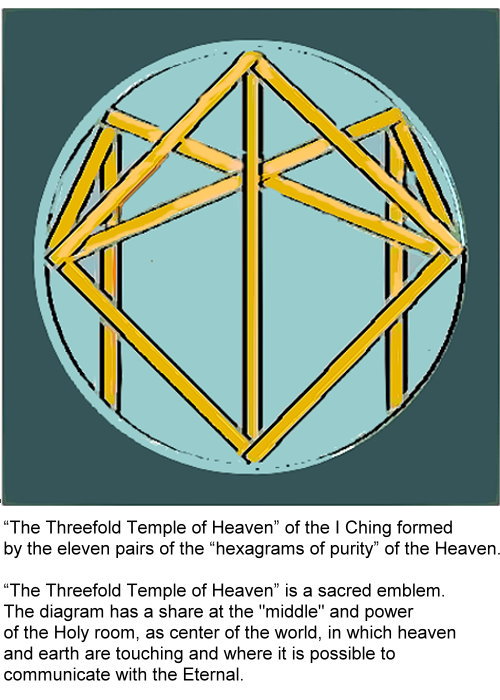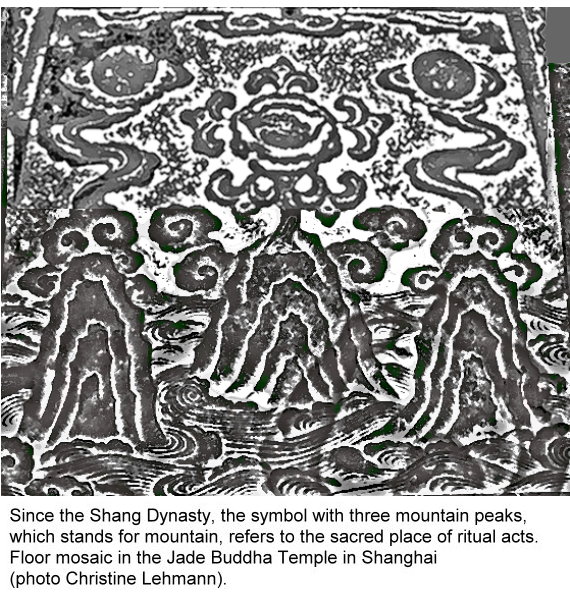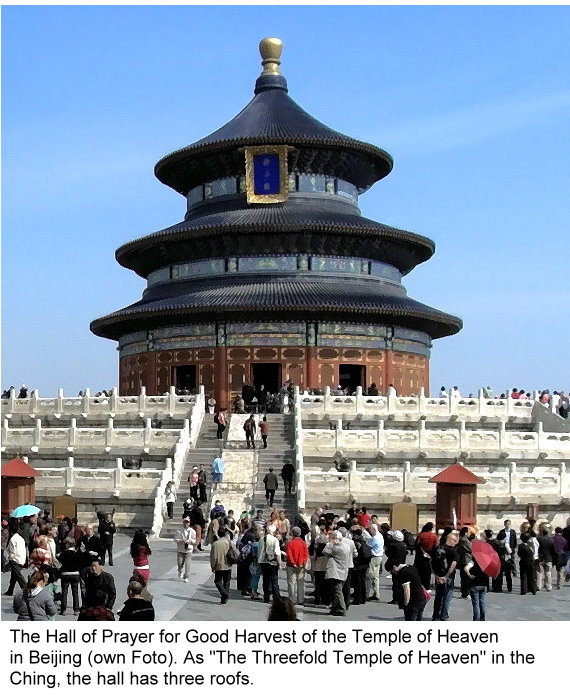The eleven pairs of the „hexagrams of purity“ of the Heaven are forming “The Threefold Temple of Heaven” of the I Ching.

Two hexagrams are a couple of purity when the two hexagrams reflect each other in the vertical and belong to the same pair group Heaven / Earth, Heaven / Man or Man / Earth. Then the hexagram pair consists of two identical trigrams in reverse order and the two hexagrams are in the same pair group. The I Ching contains 14 pairs of purity. Eleven of them belong to the pair groups Heaven / Earth and Heaven / Man. In the “Circle of the Early Heaven” graphed, these eleven pairs of purity are forming “The Threefold Temple of Heaven”.
The I Ching contains star-constellations and the graphical representation of certain hexagrams is the master plan for palaces and monasteries. This being so, the hexagrams of the I Ching may also contain other symbols and emblems, such as those of the Heaven. One had only to find the hidden features of the hexagrams forming these emblems. The idea that such „sacred monuments“ were hidden in the I Ching, let me rest any more. If these were really hidden in the I Ching, I had to find them. First I wanted to look for an Emblem as a representative of the Heaven or the great DAO behind Heaven. The highest heavenly power, people have worshiped everywhere on earth and they represented it in a variety of ways.
“The holiness of heaven is at countless ritual or mythical complexes … present, „writes Mircea Eliade. „It is through the symbolism of the „height“, the “exit“, the “center“of the religious experience and so alive …“
“The holiness of heaven is at countless ritual or mythical complexes … present, „writes Mircea Eliade. „It is through the symbolism of the „height“, the “exit“, the “center“ of the religious experience and so alive …“
I could search for a symbol of the Three Pure Ones, which were probably revered even before the Han dynasty (206 BC-220 AD) in China as the supreme divine power. They are the three manifest forms of the unfathomable DAO, the mother and nurturer of the ten thousand beings. As the highest and most abstract deities they dominate “The Early Heaven”. At the grand festival of the sacrifice they play in Daoist temples the leading role.
The Three Pure Ones are the three highest Gods in the Daoist pantheon. They are regarded as the pure manifestation of the DAO, bringing all sentient beings into existence. The Daoist classic Daodejing, says: „The DAO produced One; One produced Two; Two produced Three; Three produced All things“.
I could also search for an emblem of a mountain.
„The mountains are closer to the sky,“ says Eliade, „and this gives them a double sanctity, one hand, they have participated in the spatial symbolism of transcendence (“ high „,“ vertical „,“ Highest „etc.) and on the other hand, they are in the proper sphere, in the heaven, as the abode of the gods. Many mythologies have their holy mountain … „(The Chinese emperors offered the sacrifice to heaven on a mountain.) Often, a mountain is regarded as a point of contact between heaven and earth, so as a center through which the world axis is running – a zone in which the sacred is compressed, a place where the transition between separate regions of the cosmos is possible … „
For the symbolic representation of heavenly powers, if such a representation in the I Ching exists, should the hexagrams of heaven have been used. The hexagrams of heaven and their female partners, I knew. These were the hexagrams of the two pair-groups Heaven / Earth and Heaven / Man, left, the life-giving and right, the strong hand of heaven. But what characteristics these hexagrams should also show? In any case, of course, „purity“. For this was the property of heaven. For the Three Pure as the highest representatives of the heaven, this the name says already.
A creation myth states:
„The pure and light is above in the heaven, the gloom and gravity is below at the earth.“
This statement is attributed to Lieh-tzu, who lived from 440-370 BC.
„Purity“ is also associated with the heaven and the DAO in the Daodejing..
Chapter 39 of the Daodejing (DDJ) says:
„By the One (DAO) the heaven attains purity…“
„The heaven without purity, I am afraid he would probably fall apart.“
Chapter 45 of the DDJ then still contains the following execution of the importance of purity:
„Purity is the canon of the world.“
There raised the question which of the hexagrams of heaven in a symbolic way, are „pure.“ What means in this context at all „pure“?
I immersed myself in the ancient scriptures and gradually it became clear to me that this property by Daoist and Buddhist conception apparently deemed to exist „if a person uses his heart as a mirror and the things neither pursues nor goes toward them, he reflects but does not keep them … „
According to Zhuang Zi, this is a property of the highest man. Since he is so, „he is able to defeat the things without hurting them.“ In addition, his heart remains pure and untainted by the things of the world, as was told also..
Han Shan, a Chinese monk living in the 16th Century has commented the Daodejing. He said in his dharma- talk: “Entering into the way (DAO) is the awakening to the nature of consciousness. … It is pure.“
Sitting in silence
converts hearts into mirrors,
nothing to hold on.
„When you awaken to this awareness, then … all areas are as pictures in front of a mirror. What’s coming, does not stick, what goes, leaves no traces.“
The question was now, which of the hexagrams of the I Ching behave themselves like a mirror? I knew the answer immediately. This could be just the two hexagrams, which are composed of two identical trigrams in reversed order. When these two hexagrams unite to form a pair, then one of them shows the other as in a mirror reversed. They are (in the vertical) mirror-partners and thus in the sense of ancient Chinese also purity-partners.
A total of 28 pairs of these hexagrams are included in the I Ching.
When things happen elsewhere in the world, then it is easy, „to reflect them like a mirror and not to keep them.“Real purity“ in the sense of ancient China seemed to me to be when things are reflected that are concerning oneself or the surrounding area. Especially the own profit or loss, decline or rise should be „in the heart of the highest man only reflected, without going towards them or pursuing them“.
In this sense, „Purity“ appeared to me therefore to have of the 28 hexagram-pairs, only those who have the mirror partner in their own pair-group Heaven / Earth, Heaven / Man or Man / Earth. These are 14 pairs of hexagrams.
Eleven of them belong to the pair-groups Heaven / Earth and Heaven / Man. That should be the pure hexagram-pairs of heaven that I was looking for.
That the number of the „pure hexagram pairs of heaven“ was 11, let me take notice. In ancient China, the 11 was a special number. The ridge of the roof of the buildings in the Forbidden City in Beijing is adorned by a certain number of characters. The higher the rank of the building, the higher the number of characters. 11 was the maximum number of characters. Similarly, 11 was the maximum number of yokes in the classical Chinese architecture for a single hall. Eleven riders of a certain kind, mostly the children of the dragon, adorn the roof the Hall of Supreme Harmony in the Forbidden City in Beijing as well as the Hall of Great Perfection in the Confucius Temple in Qufu. This shows these two halls as the most senior buildings in ancient China.
Eleven days shorter
than the sun year is the lunar year.
Eleven years takes
one sunspot cycle.
Eleven are the cosmic Ten.
Eagerly I put together the eleven „pure hexagrams-pairs of heaven”, those of the left, giving hand, as well as those of the strict right hand of heaven:
Here are these hexagrams:
5. Hsü / Waiting (Nourishment) with the trigram Heaven at the ground and Water above (Heaven / Water).
6. Sung / Conflict with the trigram Water at the ground and the trigram Heaven above (Water / Heaven).
Hexagramm 6 ist Hexagramm 5 vertical reflected.
7. Shih / The Army with the trigrams Water / Earth.
8. Pi / Holding Together (Union) with the trigrams Earth / Water.
11. T’ai / Peace with the trigrams Heaven / Earth
12. P’i / Standstill (Stagnation) with the trigrams Earth / Heaven.
13. Tung Je´n / Fellowship with Men with the trigrams Fire / Heaven.
14. Ta Yu / Possession in great Measure with the trigrams Heaven / Fire.
35. Chin / Progress with the trigrams Earth / Fire.
36. Ming I / Darkening of the Light with the trigrams Fire / Earth.
17. Sui / Following with the trigrams The Arousing, Thunder / The Joyous, Lake.
54. Kuei Mei / The Marrying Maiden with the trigrams Lake / Thunder
37. Chia Je´n / The Family (The Clan) with the trigrams Fire / Wind.
50. Ting / The Caldron with the trigrams Wind, Wood / Fire.
47. K’un / Oppression (Exhaustion) with the trigrams Water / Lake.
60. Chieh / Limitation with the trigrams Lake / Water.
49. Ko / Revolution (Molting) with the trigrams Fire / Lake.
38. Kuei / Opposition with the trigrams Lake / Fire (Flame).
53. Chien / Development (Gradual Progress) with the trigrams Mountain / Wind, Wood.
18. Ku / Work on What Has Been Spoiled (Decay) with the trigrams Wind / Mountain.
59. Huan / Disperson (Dissolution) with the trigrams Water, The Abysmal / Wind.
48. Ching / The Well with the trigrams Wind, Wood / Water.
The 11 pure hexagrams pairs represent the solar cycles of the spring, summer and autumn, a pair of hexagrams, the end of winter, the cold season.

I drew a circle and ordered the eight trigrams on it at this: heaven above, earth below, fire in the middle left, water in the middle right, the remaining four trigrams also according to the circle of early or original heaven, the mythical ruler Fuxi is attributed. According to tradition, the Three Pure as well has been assigned to the circle of the early or original heaven.
Then I drew the double lines between the two trigrams, which together make up a „pure“ hexagram pair of heaven, one after another, twenty-two times. It seemed to develop a symmetrical structure. When I was finished I had to look twice and three times on it. I could hardly believe it: There was a pleasing symmetrical diagram (see Fig above), which is without doubt an emblem of heaven. Spontaneously, I called it „The Threefold Temple of Heaven”.
The double-lines, which express the pure hexagrams pairs extend symmetrically to a central axis. The display shows three overlapping cross-roofs, each of which are supported by one central post.
Two perpendicular lines are forming the double bottom.
The two double lines, on which the temple is standing, symbolize the basis for life on Earth. The double line between fire and earth represents the rising and setting sun and day and night (hexagrams 35 and 36), the double line between water and earth the falling of rain on earth (hexagram 8) and the water contained in the earth and gushing from wellsprings (hexagrams 7). The central pillar of “The Threefold Temple of Heaven“, is formed by the two most important hexagrams of the I Ching, namely the hexagrams
11. T’ai / Peace with the trigrams Heaven / Earth
12. P’i / Standstill (Stagnation) with the trigrams Earth / Heaven
The central pillar is connecting heaven and earth and corresponds to the world ash tree in Germanic mythology, also connecting heaven and earth.
What should this “Threefold Temple of Heaven” represent?


The diagram of the eleven pure hexagram pairs remembers of an ancient symbol with three mountain peaks, which stands for mountain. (1650-1050 BCE.) Since the Shang Dynasty, it refers to the sacred place of ritual acts. It is one of the most common characters written.
In the oracle bone inscriptions (17th-11th century BC), the three peaks are equally high, but since the bronze font (11th century-256 BC) the middle peak is higher than the other two.
Maybe the figure shows the three peaks of a sacred mountain. According to old ideas are mountain peaks sacred places where the worlds of the profane mingle with those of the divine, and on which a passage from one to the other world is possible. The mythical ruler Fuxi, which is associated with the circle of the Early Heaven, is until today depicted as a mountain. The head of Fuxi rises from the top of the mountain shrouded by foliage. Peaks appear to the people especially „pure“ when they are covered by pristine white snow reflecting sunlight. This is a grand sight.
The gender of the Xia (about 2200-1800 BC.), whose origin is Fuxi, led off their power from the religious worship of sacred mountains.
In particular, the mountain Tai Shan in China is the place to meet the deities of heaven and earth. Located in the east, the Tai Shan represents sunrise, spring and a new beginning. For new dynasties he was of great ritual significance. A ruler had only the mandate of heaven after he had made his respects to this mountain. Only on Tai Shan is said to be the ruler possible to perform the feng and shan sacrifices, and to communicate with the heaven.
Until modern times, there has been the cult of sacred mountains. The five sacred mountains of Taoism were especially of great importance in China’s ancient world. They are located in all five directions, and are places of sacrifice since time immemorial. On their summits are many Taoist temples.
In the Temple of Heaven in Beijing with its three stacked roofs since the Ming-dynasty the emperor performed the sacrifice at the winter solstice and prayed. The rectangular three-level terrace, on which the temple stands, is the earth, nature and the human world. The three-tier roof with the blue bricks and the crowning jewel, however, means the golden heaven. It is supported by pillars, which represent the seasons.
The “Threefold Temple of Heaven” I rediscovered in the I Ching, corresponds in shape more like a holy mountain. In any case, so the Heaven was appreciated. The Zhou (1050-226 BC.), which have provided the hexagrams with texts derived their power from the heaven. They were organized patriarchal and felt even more than the other dynasties before them as the sons of heaven, as did also the later Chinese rulers until the twentieth century.
“The Threefold Temple of Heaven” is a sacred emblem. The diagram has a share at the „middle“ and power of the Holy room, as center of the world, in which heaven and earth are touching and where it is possible to communicate with the Eternal.
